Exploring Scenarios In Sharp Practice – Part Three: The French & Indian War
November 28, 2017 by crew
Welcome to Part Three of our look at the different periods of Sharp Practice and the games we can play using the system. Today we're jumping in the time machine and heading to the Virginia backwoods in the year 1756. After General Braddock's defeat, the British army in North America needed time to recover and the settlers were left to their own devices.
Read Part Two Here
French raiding party's descended on the frontier in an attempt to drive the settlers out who were defended by the struggling Virginian Provincials and local volunteers.
The History
The British blundered into a massacre at Monongahela which left the settlers and civilians defenceless to the French & Indian raids that followed. While the British rebuilt their army in North America, the defence of the frontier was left to men like Major George Washington, his Virginia Provincials and local volunteers who fought in small skirmishes and counter attacks.
While the British invaded Canada, the frontier still needed to be defended and it was a far less glorious post for an aspiring officer like Washington than accompanying Generals into "proper" combat.
In this scenario the local area has been facing raids by a French raiding party encamped nearby and they're finally ready to act proactively. The next French target has been identified as a farmhouse, and the British have mustered as many volunteers as possible before setting out towards it.
This scenario will showcase the massive variety of colours and uniforms of the period and show that not all historical games are boring lines of the same guy over and over again.
Shuffling The Deck
The British force is attempting a rush to defend the farmhouse while the French force is trying to burn it to the ground and escape the field. The French deployed in the centre of one edge and the British opposite them with the Farmhouse in the centre.
The British advance up the centre flanked by the settlers to their right and the Rangers to their left. The French concentrate their Regulars in the Centre and match the British settlers with their own settlers backed up by Indian Allies while they send Coureurs des Bois to engage the Rangers.
The Coureurs des Bois open fire on the Rangers while the Regulars and Indian allies go toe to toe with the British Regulars and Militia in a deadly firefight that occurs for several turns with no one side emerging as a winner. During this firefight, the Coureurs des Bois manage to light the farmhouse forcing the Rangers to abandon their fire support and barely keep the fire contained until they finally put it out.
The Rangers get into the flank of the French and now have to make a choice. Do they make a run for the French deployment point and deal a blow to French moral or do they give their allies support and try to turn the tide?
Give Them The Bayonet!
The French & Indians charge the British and manage to drive off the Militia but the Regulars manage to achieve a pyrrhic victory with only a handful of men left after routing the French and capturing their leader. The Settlers manage to drive one another from the field while the Indians get into a position to withdraw. The Rangers begin to fire on the French centre after the British defence there all but collapsed.
The British push back the Indian allies while the Rangers finally manage to kill a few Coureurs des Bois and send them into a route. The French are on the backfoot but the British aren't much better and both sides are low on Force Moral. Now here comes the big narrative decision, do the French put it all on the line to burn a farmhouse? Do they make one last push? Or, do they call it a day and retreat?
The Indians troops take stock of their situation, all their allies are gone, the British have two ragged units left. With a desire to preserve his men's lives the Sachem orders a retreat and concedes the day to the British. The British have driven off the French and saved the farm.
Reflections
In this game, we see how trading fire isn't always the best option but maybe the safest. When the two sides stood off and traded fire the French and British took around the same casualties but during the melee, the French were essentially wiped out and the British weren't much better off.
The French could have, instead of wasting a turn getting into position to fight the British, immediately set fire to the house and fought their way back keeping enough pressure on the British that they couldn't put out the fire which would have saved them a bloodbath in the melee but could have made it even harder to torch the house if the fire had been put out.
Sharp Practice makes players decide, do you complete your objective and run for your life while hoping the enemy doesn't kill you in the process or do you engage the enemy, get some breathing room and set the building on fire. The French decided to get into a stand-up fight with numerically superior troops even though the French and their Indian allies were better in combat.
Living To Fight Another Day
A voluntary retreat is also a feature of Sharp Practice that seeks to emulate reality and help the players tell the story. Do your last few ragged survivors make that valiant last stand or do they fight another day? In this situation, we decided it was a better story that the French retreated rather than fight to the last. This was after all just a raid and with no actual French troops left we felt it was unlikely that native allies would sacrifice themselves.
While players can just play the rules and have a great game what really unlocks Sharp Practice's potential is when the players get into the story. Native allies burning down a farmhouse doesn't really call for a sacrifice but holding up a French advance to cover your retreating comrades does justify fighting to the last man
Melee is extremely deadly, rather than rolling to hit and having a one in six chance of killing the enemy you now just make a straight one in three roll to kill. The French, who were outnumbered roughly two to one, decided they would be better off shooting it out with the British rather than get involved in a melee where their small units would be in danger of being decimated. The British on the other hand had no incentive to send their lower quality and numerically superior troops into a melee they could easily lose.
Deciding How To Fire
Both sides decided to fire their men uncontrolled. This meant that firing only took two actions, fire and reload, instead of adding the third Present step. The players decided that rate and volume of fire mattered more than accuracy and the game of chicken was played throughout the whole firefight. If one side took the time to start presenting then their opponent would do the same and the relatively safe firefight would very quickly get a lot more intense.
While we normally see intense firefights as a good thing in this example the French and British were just trying to hold the centre while their flanks duelled it out. If the British player had routed the French earlier his flank would be open to an Indian counter charge while the Militia and Rangers made the French nervous about pushing until it was absolutely necessary.
The Settlers both broke and then the Rangers and Coureurs des Bois moved in to burn the house and made the centre more vital and one side needed to resolve it immediately before both forces were charged in the flanks and everyone was in trouble. One thing to always keep in mind is that you don't always want to be driving forward unsupported and if you do plan on a general assault you better be sure it'll succeed or your army can be cut to ribbons in the crossfire.
The French could have replaced their settlers to give them more bodies and more muskets. The British on the other hand could have given up their flanking settlers to increase the regiment size of their line troops and better prepare themselves for the straight up fight they were looking for. List building in Sharp Practice does force you to make sacrifices with forces chosen from a set list and each player receiving a set number of points to buy extra troops, upgrade their existing troops or buy special add-ons like preachers, specialists and wagons to their force.
The British, having a lower points value, received enough points to buy some Rangers but not much else while the French had the freedom to take their pick and tailor their force towards what they needed for the game. They could have taken some more Regulars instead of the Indians or even more Indians instead of the Coureurs des Bois which would have drastically changed the way the game turned out.
What do you guys think? Would you have raced for the objective and hoped to survive the enemy firepower, stand off and fight them or roll the dice and charge?
The next instalment is the one you've all been waiting for. We're headed to Spain where a Light Infantry detachment, accompanied by Riflemen have to hold out in a Spanish monastery while reinforcements arrive to get them out.
Post some comments below and let @Elessar2590 know what you thought.
If you would like to write an article for Beasts of War then please contact us at [email protected] for more information!
"The British force is attempting a rush to defend the farmhouse while the French force is trying to burn it to the ground and escape the field..."
Supported by (Turn Off)
Supported by (Turn Off)
"Do your last few ragged survivors make that valiant last stand or do they fight another day?"
Supported by (Turn Off)

































![TerrainFest 2024! Build Terrain With OnTableTop & Win A £300 Prize [Extended!]](https://images.beastsofwar.com/2024/10/TerrainFEST-2024-Social-Media-Post-Square-225-127.jpg)







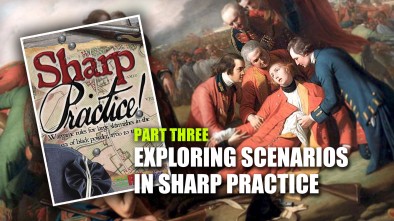
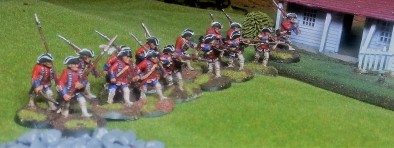
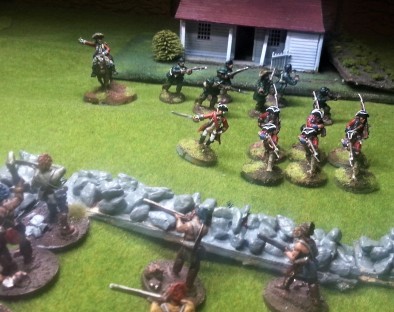
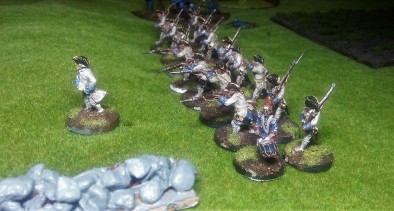
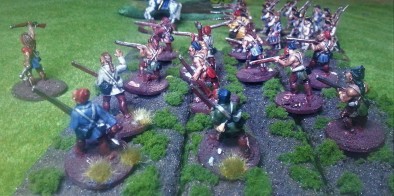
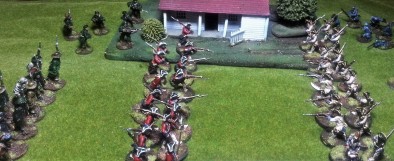
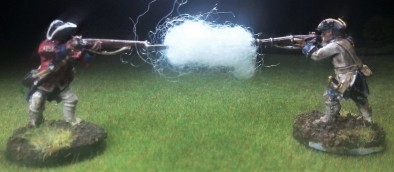
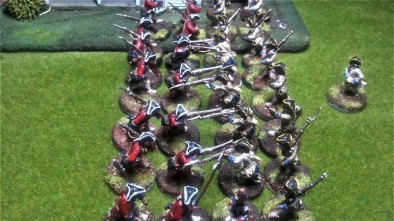


































Another awesome article, @Elessar2590 – brings back memories of your great French and Indian War series in 2015-16. http://www.beastsofwar.com/muskets-tomahawks/french-indian-war-part-one/ I also like how the British regulars routed the French after the bayonet charge. British regulars (or God help you, grenadiers) were no joke, and any game worthy of the name portrays the British “cold steel” as a truly fearsome weapon. Indeed, melee is the game-ender in black powder. In the Revolutionary War hit rates were as low as one round in 300, yet when it comes time to put a bayonet in someone the hit rate is usually “one out… Read more »
Thanks @oriskany The way Sharp Practice deals with situations like this is through the quality system. So British Regulars are one Quality level above Continental Line so get more dice per group. Funny you mention it because in the first game we played the British had Highlanders as their core and the French Force was almost all light infantry with a lot of Native Allies. It was a total bloodbath with the Native Americans shot to pieces by Rangers and the skirmishers routed by the Highlanders. It was such a one sided game we had time for another which turned… Read more »
The Native Americans got hit hard due to their “Prominent Leader” rule … I was going to ask if the “quixotic” nature of Native American units came through in this system. Nothing against them or their courage, they could be absolutely terrifying when they were fired up in combat. It’s just that these weren’t usually “their” wars, and were involved for totally different reasons than their French, British, and (later) Patriot counterparts. Sometimes they’d realize they just weren’t getting anything out of a given campaign or battle, and had no problems simply leaving. Aiee, Highlanders. That’s gotta be a tough… Read more »
Native Americans are more of a flanking force for getting where your opponent doesn’t want them. They aren’t great at shooting but can do some serious damage to skirmishers or artillery in close combat. Pick low hanging fruit and be a nuisance and leave the Regulars for your core troops. Prominent Leader basically means they drop in quality and roll twice for Force Moral meaning if you take a Large Native American contingent in your force their moral will drop very quickly. Highlanders were in North America during the French and Indian War and they feature in a lot of… Read more »
. . . if you take a large Native American contingent in your force their morale will drop very quickly.
Indeed, this kind of thing happened at the Battle of Oriskany and many other places in the northern theater of the Revolution. Once the “profit / loss” balance tipped the wrong way, or it became clear that the white officers in charge didn’t have their interests at heart, these Native American contingents saw no reason to continue to risk their lives and property in someone else’s war.
Thanks for the tip on the 71st Highlanders. I honestly never knew that.
While I don’t know much about this period of history or the game system, I do know something about black powder mini’s and boards, and I gotta say @Elessar2590, yours look amazing. You managed to get a lot of beautiful detail. It really helps them stand out on the boards.
Thanks a lot. i can’t take too much credit the Minis are so well sculpted even a trained monkey like me was able to make them look passable. All of them are extremely well sculpted and very easy to paint which makes life so mush easier.
Well you are a very well trained monkey then, because I have managed to mess up a great mini…I’m talking early Justin painting.
Can’t wait to see more of them!
“early Justin painting” . . .
A three-inch brush then? 😀
Great article. I think I recognize that painting, is that James Wolfe on the Plains of Abraham?
Indeed it is. I think it’s a great example of all the different uniforms of the period plus very famous.
The French Indian War. An interesting little conflict with from I remember have some British Generals some valuable experience when it came for them to lead the American Revolutionary Armies. I’ve always wondered if it should just be included in the overall heading of The Seven Years War
Nice article again my friend
Thanks a lot glad you enjoyed it. I separate them mainly for convenience. It’s probably more accurate to call it ‘The North American Theater of the Seven Years War (which actually lasted 6 Years as is tradition)’. I consider it to be another theater, the French especially saw it as secondary to the European War “One does not concern himself with the barn while the house is one fire”. There was fighting in the Caribbean and India as well but I know nothing very little about those theaters. A lot of British Generals got the bulk of their combat experience… Read more »
a great read @elessar2590 interesting to see army’s cant just bonus up and steamroll every thing.
Glad you liked it.
Sharp practice is a different type of game because you actually get the sense that your troops aren’t really under your control once things start going bad and you’re just trying to keep a shattered force under control. You can use cards to boost your units but they don’t get super powers just an extra dice or inflict a few extra points of shock.
Great stuff, for me one of the most important sentences was “Sharp Practice makes players decide, do you complete your objective and run for your life while hoping the enemy doesn’t kill you in the process or do you engage the enemy, get some breathing room and set the building on fire. The French decided to get into a stand-up fight with numerically superior troops even though the French and their Indian allies were better in combat.” Being forced to make choices like that is what wargaming is all about, even more if it is part of a campaign where… Read more »
Thanks glad you like the article.
Sharp Practice really makes you think ahead and make hard choices. The next article is a great example of that (little teaser) where three times the Players had to drastically change their plans because their troops didn’t do things fast enough or the cards didn’t work they way they wanted them too.
I’m currently trying to organise a Campaign over the Christmas Holidays (keep an eye on the forums around new years) with a few friends. The last article of the series focus’s on Campaigns and linked games so stay tuned.
An interesting article focusing on the tactical and force composition choices the players must address. Thanks again for showing us the inner workings of Sharp Practice.